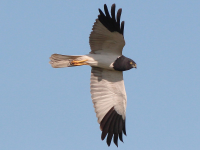As well as the Black-winged Kite that was I/Dd yesterday, I also frequently spot another buzzard-like species, flying above the rice paddies outside my home. Sometimes, usually mid-to-late mornings, they fly in pairs or more, calmly circling on the thermals, whilst every evening, just before sunset, a single bird circles, then hovers, wings beating (Kestrel-like), seemingly hunting its dinner, before diving down to catch it!
My Google search is telling me that these raptors are Oriental Honey Buzzards, confirming their size, shape and behaviour, but I'll be more than happy with any further help towards I/D-ing these intriguing visitors to 'my big garden'!
My Google search is telling me that these raptors are Oriental Honey Buzzards, confirming their size, shape and behaviour, but I'll be more than happy with any further help towards I/D-ing these intriguing visitors to 'my big garden'!







